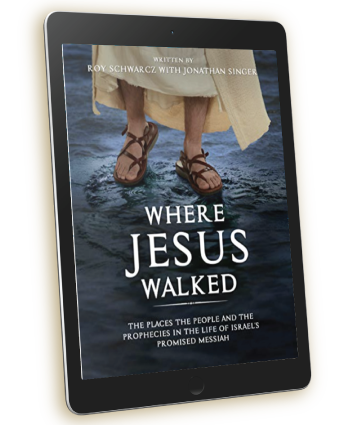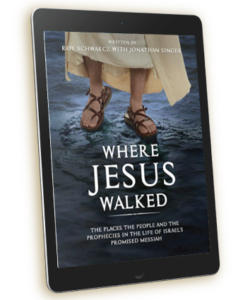Zechariah 6 gives to us the eighth vision seen by Zechariah and concerns four horses, four chariots, and two mountains of brass. This vision is related to Zechariah’s first vision of four horses dispatched by the rider on the red horse, who was shown to be the Messiah. In this final vision, the angelic riders have traveled among the nations to determine their relationship with Israel. The nations were declared to be peaceful and at rest.
The four chariots are vehicles of God’s judgment. In Zechariah 1-4 God’s plan for Jerusalem and the Jewish people was revealed. The Temple would be rebuilt, and the Jewish people will be cleansed and become a reflection of God’s light in the world. In Zechariah 5, God’s judgment fell on sinners and sin. In this final vision, the Lord speaks of His final judgment against the Gentile nations of the world.
When the events of the vision are completed in the Last Days, the world will be prepared for the coming of the Messiah to rule the earth. This is portrayed in symbolic form with the crowning of Joshua the high priest.
Zechariah 6:1 – The four chariots and the four horses speak of war sent from the Lord and as is the case so much in Scripture war is an outpouring of God’s judgment. The four chariots come out from two mountains of bronze. Bronze or brass is often a symbol of judgment, for example the serpent that was raised in the wilderness that brought deliverance from judgment was made of bronze, and Jesus used it as a picture of Himself in John 3 when he took upon Himself our judgment. Most commentators believe that these two mountains are Mt. Zion and the Mt. of Olives. Between these mountains is a major valley, the Kidron.
The vision of Zechariah 6 depicts the horsemen and chariots going down the Kidron Valley, bringing the judgment of the Lord on the nations. This will occur at the conclusion of the Battle of Armageddon when the Lord returns in triumph. The details agree with the writings of the other prophets, who speak of the battle taking place in the Valley of Jehoshaphat (Heb. Jehovah judges). No location in the Bible is actually named the Valley of Jehoshaphat; however, many Bible scholars believe that it is the Kidron Valley, renamed in the last days. The Scriptures could well be speaking of the valley Jesus will create when He splits the Mount of Olives at His return (Zechariah 14:4-5).
Zechariah 6:2-5 The colors of the horses here are the same colors as those recorded in Zechariah 6:1. They also resemble the horses of Revelation 6. The importance is not just their color but that they are harnessed to chariots of war, ready to bring God’s judgment on the world. The emphasis is on the change in direction the judgment takes from Israel to the whole earth. As before, Zechariah did not understand the meaning of what he saw. In Zechariah 6:4 he asks and is told the answer in Zechariah 6:5. “What are these, my lord?” he asked (Zechariah 6:4).
The angel replied, “These are the four spirits of the heavens, which go forth from standing before the Lord of all the earth” (Zechariah 6:5). The number four relates to other phrases used in prophecy. For example, the four Gentile kingdoms mentioned in Daniel 2 would affect Israel. We find it in Isaiah 11:12 and speaks of the whole world. So from this expression also we understand this is speaking of judgment coming on the world.
Zechariah 6:6-8 The black horses, represent famine and death, are directed toward the “north country” . Many of Israel’s enemies in history came from the north—some from the fertile crescent, such as the Babylonians, and the Assyrians. Ezekiel 38 also speaks of an enemy allied with other nations that will move against Israel from the north. The white horses follow after the black and symbolize peace or victory.
Following the famine and death inflicted on the enemies of Israel, victory will come. The dappled or pale horses head south, toward Egypt, who was often an enemy, although she never really conquered Israel. From the north, Assyria and Babylon are singled out for special judgment for having overstepped their bounds in punishing the Jewish people.
Babylon is especially singled out because she was the birthplace of the evil, self-centered, materialistic, idolatrous system of commerce and religion. That system has permeated the world, and Babylon faces severe judgment because of it. Finally, after eight visions and the promises so wonderfully woven in them, God brings His plan for the earth to its prophesied end. Sin and sinners have been dealt with, and judgment has fallen.
All is prepared for the ushering in of the Messiah and His rule upon earth. This all is given to God’s people who have returned from Babylon after God’s judgment upon them. God is saying I have not nor ever will totally forsake you. I have disciplined you and will discipline you again but I love you and have a future and hope for you. This is a message for us as well. God’s discipline is for our good and will ultimately bring great blessing. They and we can rest assured, that God is proceeding according to His plan in spite of Satan’s opposition.
Zechariah 6:9-15 Zechariah was told to accept the gifts of silver and gold that would be brought by three exiles returning from Babylon, Heldai, Tobijah, and Jedaiah. These gifts came from the Jewish community still living in Babylon who had not come with Zerubbabel in 537 b.c. or with Ezra’s in 458 b.c. or Nehemiah’s in 445 b.c.. These three men entered the home of Joseph the son of Zephaniah, the prophet was told to go there to receive gifts they had brought for the construction of the Temple.
Zechariah was to take some of the sliver and and gold, and make crowns, and set them on the head of Joshua, the high priest. The high priest is given a dual role of priest and king! The word “crown” in Hebrew is actually the plural “crowns” and points to the Messiah who was to come as both priest and king. Remember under God’s law a priest could not be a king and a king could not be a priest.
What we are given here in Zechariah 6:12-13 are 5 messianic promises:
1) “The Man whose name is “the Branch” . This is a promise that a Davidic king would rule in the coming new age. This title appears in the Older Covenant about the coming Messiah. In Jeremiah 23:5 we learn about “The Branch” as King. This is the overriding theme of Matthew. In Zechariah 3:8 – The Branch as Servant which is the overriding theme of the Gospel of Mark. Here in Zechariah 6:12 we see him spoken of as “The Man whose name is the Branch” which corresponds to the presentation of the Messiah in Luke. And Isaiah 4:2 He is described as “The Branch of the Lord”. John’s gospel presents Yeshua as the Son of God.
2) The second Messianic promise in this chapter is “He shall branch out” . Messiah, though He came out of dry and parched ground (Isaiah 53:2), would be elevated and prosper in accordance with His very own nature—He would, as the “Branch”, branch out. This has been and continues to be realized through the work of Gospel of Yeshua going through the entire world. .
3)“And He shall build the temple of the Lord” . While Zerubbabel the governor, with the prompting of the prophets Haggai and Zechariah, built the second temple in 515 b.c., Messiah himself would build a new temple (Isaiah 2:2-4;Ezekiel 40-42;Micah 4:1-5;Haggai 2:7-9). Not only would Messiah be in charge of the building of this new temple, but “He shall be clothed with majesty” (Zechariah 6:13b). This speaks of the glory and splendor of God that is full invested in Yeshua (Psalm 2;Psalm 96:6).
4. “And [He] shall sit and rule on His throne” (Zechariah 6:13). God had long ago promised that the son of David would sit on the throne of his family and that that throne would endure forever, unlike all worldly kingdoms or governments (2 Samuel 7:12-16). In the fullness of time Messiah came (Luke 1:32-33). All power and all authority in heaven and earth belong to the Messiah, who would one day sit on David’s throne.
5. “And he will be a priest on his throne. And there will be harmony between the two.’ (Zechariah 6:13). This is the greatest prophecy that the coming Messiah will be both a Davidic king and a Priest (Hebrews 7; Psalm 110:1-4). Zechariah combines the priestly and kingly offices into one person, “the Branch.” Only the Lord himself could bring “peace” to this earth by dealing with the sin of the world in one day (Zechariah 3:8-9). Jesus, will once again deal with sin and remove the sin of Judah in one day (Zechariah 12:10;13:1).
Furthermore, in this one person of the coming Branch, all tension between the offices of religious and political leadership will be resolved.
The crown described in Zechariah 6:11 would be stored “as a memorial in the temple of the Lord” (Zechariah 6:14), as a reminder of the gift from the Jewish community in Babylon and as a testimony of the coming union of the priest and king in the office of Messiah.
There that crown would stay “Until He comes whose right it is” (Ezekiel 21:27;Genesis 49:10).
In Zechariah 6:15 we have a reference not to Zerubbabel’s temple, but to the millennial temple that Isaiah 2:1-4,Micah 4:1-4, and Ezekiel 40-48 spoke of. Like the Jewish community in Babylon who sent gifts of silver and gold to make the double crown, “those from afar” (Gentiles; Acts 2:39;Ephesians 2:13) would bring their gifts and help build the millennial temple.
To a degree this has begun even today through multitudes of Christians who are building the “living stones” in Israel through their gifts and support to Jewish evangelism in Israel and in the diaspora. The eight visions, and the first main section of the book of Zechariah, concludes with a warning, from Deuteronomy 28:1, that God’s blessings were promised to those who walked in obedience.


